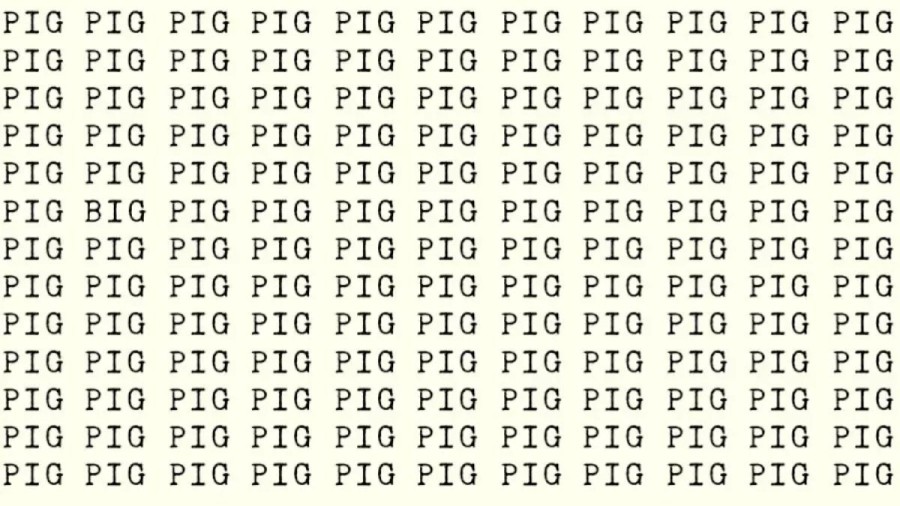Brainteaser challenge for great minds
One of the popular brainteaser types is the picture puzzle, which involves solving visual puzzles or riddles. These puzzles can come in many forms, including jigsaw puzzles, spot-the-difference puzzles, and hidden object puzzles. Regardless of their form, picture puzzles require puzzle solvers to carefully observe and analyze the visual elements presented to them in order to solve the puzzle.
- Brain Test: If You Have Sharp Vision Find Third In This Picture In 22 Secs
- Observation Brain Test: If you have 50/50 vision Find the number 3123 among 5123 in 12 Secs
- Move 1 Matchstick to Fix this Equation in 20 Secs I Matchstick puzzle
- Brain Teaser: 4×9=46 Fix the Equation by Move 2 Matchsticks | Matchsticks Puzzle
- Brain Teaser Picture Puzzle: Can You find the Profession name from the Clues?
The Find the Difference puzzle contains two almost identical images, but there are subtle differences between them. The solver’s task is to find all differences between two images. These puzzles often require careful observation and attention to detail, as some differences can be quite subtle. Hidden object puzzles, on the other hand, involve finding a specific item or object within a larger image. These objects may be hidden in the background or disguised in some way, requiring the solver to carefully examine the entire image to find all objects.
You are watching: Brain Teaser: If you have Eagle Eyes Find the Word Big in 15 Secs
Additionally, picture puzzles can be a great tool for stress relief and relaxation. The process of focusing on the puzzle and solving the visual puzzle can help calm the mind and provide a sense of accomplishment once the puzzle is completed. Overall, picture puzzles are a fun and engaging way to exercise your mind because they require careful observation, analysis, and problem-solving skills. Additionally, they can be a great activity to do with friends or family, as they can be done alone or as part of a group.
Brain Teasers: If you have an eagle eye, find the big words in 15 seconds
Picture puzzle questions are a type of brain teaser where the questions are based on visual images or pictures. They come in many forms, such as riddles, brain teasers or trivia questions. Regardless of the format, solving picture puzzles requires the solver to carefully examine and examine the visual elements presented to them. A common type of picture puzzle is the “spot the difference” puzzle, which provides two images that are almost identical, but with subtle differences between them. The solver must find and identify all differences between the two images, which can be very challenging as some differences can be subtle. Another type of picture puzzle is a visual riddle, which presents a visual image or picture and asks questions based on what is depicted in the image. For example, a visual riddle might present an image of a person standing in front of a door, holding three keys, and ask which key opens the door. These puzzles require the puzzle solver to carefully analyze the image and may require lateral thinking to arrive at the correct answer.

We pose a question to you in the image above. Try to solve it by following the rules applicable to this brain teaser. Your time to solve the puzzle begins now, so give it your best shot!
If you can’t solve this puzzle, don’t worry. You can continue reading the article to find the solution.
trend
Brain Teasers: Find Big Words in 15 Seconds If You Have Eagle Eyes – Solution
See more : Brain Teaser: If You Have Sharpe Eyes Find The Word Flash Among Flesh
We will find the answers to the difficult questions posed in the article above. We’re all eager to know the answers, so let’s get started. First, we’ll reveal the answer and then explain the reasons behind it. Don’t worry if you can’t solve the puzzle; brainteasers should be fun, not stressful. If you stay calm and relaxed, you can even solve the difficult problems before us.
We believe every problem has a solution. While some puzzles may seem challenging, the answers may be simple. On the other hand, some puzzles may seem simple but require effort to solve. Ultimately, the difficulty of a puzzle depends on the specific puzzle itself.

Looking closely at the picture above, we get the answer. The answer is given not only to those who did not find it, but also to those who predicted it wrong. It’s okay to make mistakes, as long as we learn from them. If you want to know the answer, keep reading this article.
In each puzzle, there is a reason why a particular answer is correct. Everyone may have their own reasons when looking for answers, but ultimately there is only one right answer and one specific reason. This is especially true for brain puzzles. Let’s take a closer look at why this answer is correct.
Disclaimer: The above information is for general information purposes only. All information on this website is provided in good faith, but we make no representations or warranties, express or implied, as to the accuracy, adequacy, validity, reliability, availability or completeness of any information on this website.
Source: https://truongnguyenbinhkhiem.edu.vn
Category: Brain Teaser
